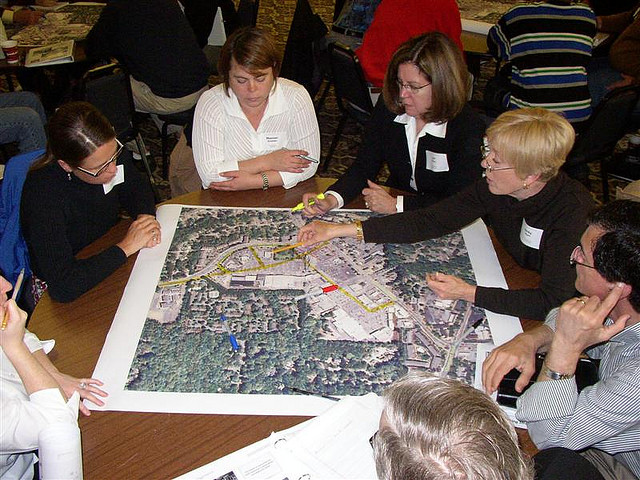Community workshops and events can accommodate many people and provide an opportunity for local government or a developer to both communicate messages and hear from the community. Community groups may also be able to help with organisation and facilitation of large events.
One example of community participation related to mobility infrastructure is from Newcastle City Council in England. The Council began developing a city-wide Movement and Access Plan in 2010. They recognised the importance of mobility for health equity and wellbeing alongside sustainability and economic development issues.
A team of transport planners, representatives of vulnerable people and healthy policy staff spent five months preparing for an engagement event with local residents to gather views about mobility issues in the city. The group gathered existing data and asked a range of community groups to prepare posters about travel in the local area.
There were 90 people at the event which began with a drama performance to highlight the difficulties older people face when leaving the house. The ice-breaker was followed by small group discussions in nine ‘Travel Zones’ using the prepared posters.
In the small groups, participants used stickers to connect their ideas to improvements across the wellbeing topic areas: social wellbeing/inclusion, physical wellbeing, emotional wellbeing, financial wellbeing or environmental wellbeing.
Voting pads were used to gather data during the event. Respondents reported having the greatest difficulty getting to leisure and learning opportunities, followed by family and friends, work and shopping. People described a number of barriers to getting around on foot and they developed solutions to address these issues.
Barriers included:
• parked cars on pavement
• pot holes
• loose pavements
• road safety
• facilities
• slippery pavement surfaces
• width of roads and pavements
• wheelie bins obstructing pavements
• poorly lit subways
• off putting shrubbery
• litter
Solutions to these issues included:
- railings on pavements to prevent car parking
- better maintenance of paving
- improved lighting
- restricting height of plants
- inspection of city pedestrian crossings with the Disability Forum
- better winter maintenance
- resolving issues with drainage channels and accessible buses
- addressing hazardous metal studs in the city centre
Organisers said that the event helped to build a sense of common understanding of the mobility issues facing people in the city. It also helped the transport and planning officers connect with different stakeholders and residents. The event supported a bid to a Local Sustainable Transport Fund.
Further information
Getting out and about easily. 2011. Newcastle Partnership. Available from: https://www.wellbeingforlife.org.uk/sites/default/files/Getting%20out%20and%20about%20easily%2018th%20Feb%202011.pdf (accessed Sept 24, 2016).
Getting out and about easily by Foot: Tablecloth Comments. 2011. Available from: https://www.wellbeingforlife.org.uk/sites/default/files/GOAB%20Easily%20by%20Foot.pdf (accessed Sept 24, 2016).
The information in this post is summarised from the report ‘Healthy Planning and Regeneration: innovations in community engagement, policy and monitoring‘.
Image credit: Peds.org, design workshop

